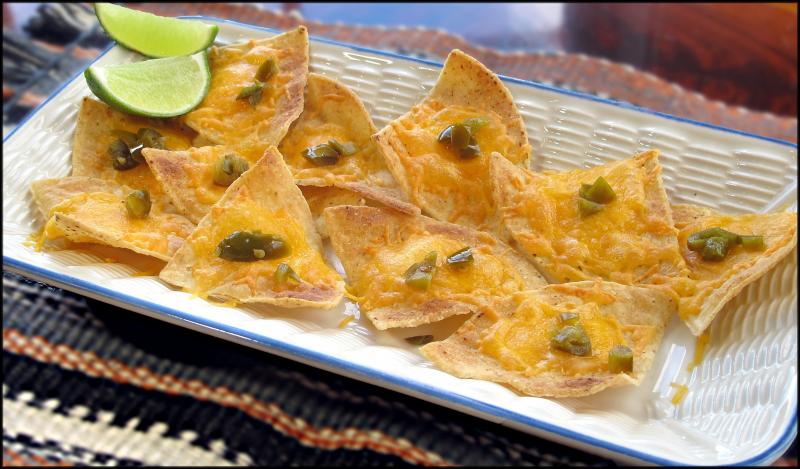Nachos: Beyond a plate of pub fare
While channel-surfing last weekend, we stumbled across a food-travel show exploring pub fare favorites. One of the interesting features covered the origin of nachos. To our surprise, they looked nothing like what’s served in restaurants today, but like the plate of treats in the photo.
The happy accident that led to the creation of nachos happened in 1943 when a handful of military wives from Fort Duncan (west of San Antonio along the Mexican border) arrived at a place called the Victory Club in Piedras Negras, Mexico. Here, the chef was on a break, leaving Ignacio Anaya (the maître d’) to invent a snack with what he could find in the kitchen.
He cut round tortilla shells into triangles and deep-fried them to a crisp. He arranged them on a serving platter and grated cheddar cheese over them, then placed them under the broiling-temperature heat in a salamander (more on that below). A scattering of sliced jalapeños completed the dish and the hungry guests were delighted.
When asked what they were eating, Anaya named the canapés after his own nickname, “Nacho,” calling them “nachos especiales” or special nachos. Success followed the innovative cook, who went on to work at the Moderno Restaurant, where his original nacho recipe is still used. He opened his own place, Nacho’s Restaurant and his son, Ignacio Anaya Jr. still tells his father’s story.
Back to the salamander - this kitchen tool has its origins in the 17th century when an iron disk at the end of a long handle was used to directly heat food. The hot disk was placed on top of the dish to brown or crisp the top, in a fashion similar to the way a blowtorch caramelizes the sugar on a crème brûlée.
As technology evolved, the salamander became more like a toaster oven without a front door. Most commercial kitchens mount these on the wall, about eye level, above the stove top. They are typically about three feet long, with gas heat preferred over electric. These are used to keep food warm, finish dishes, brown surfaces and melt cheese.
Why are these ovens are called “salamanders”? In ancient Greek, salamander was the word for any “fire animal.” The actual lizard we call a salamander lives in damp areas, such as among fallen creekside branches. According to legend, when damp logs were brought to the fire pit, sleeping salamanders would awake and scramble out, giving rise to the notion that they can withstand flames or come back to life after being set afire.
You don’t need a salamander to make good nachos, but I have learned that this is a dish where less can be more. The traditionally over-garnished nacho platters on restaurant menus are a mountain of chips laden with chili, guacamole, chicken and multiple types of cheese. When reaching in for a chip, you have to make sure it's from the top layer or all you get is a dry chip.
If you follow the steps of the original nacho recipe, you’ll find each chip is uniformly garnished with melted cheese and pickled jalapeños. Because they’re heated in a single layer, all the chips are warm and crisp, accentuating their signature corn essence. Whether using white corn chips, yellow or blue, the true flavors of a nacho are three: crisp corn, melted cheddar and spicy jalapeño pepper.
I’ve included the instructions for making the original “special nachos” as well as a recipe for another pub dish, this one from J. Gilligan’s Bar and Grill in Arlington Texas. Called “Irish Nachos,” they use cottage fries (thin-sliced potatoes mixed with onion and peppers) instead of corn chips as the base.
Although the restaurant deep-fries the sliced potatoes, you can oven-fry them or substitute a package of frozen waffle fries (baked, of course). Another way to enhance the Irish influence on the flavors is to fry and crumble bacon to stir in with the cheese, reserving the rendered fat to sauté the onions and peppers. No matter how you make them, enjoy some different versions of nachos.
Original Nachos
corn tortilla chips
shredded cheddar cheese
pickled jalapeño peppers, chopped or sliced
Preheat broiler to 550 F. Arrange chips in a single layer on an oven-safe serving platter. Cover each chip with shredded cheese. Place under broiler until chips begin to brown at the edges and cheese is melted, about 3 minutes. Sprinkle with jalapeños and serve immediately.
Irish Nachos
2 Russet potatoes*
2 T olive oil
salt & pepper, to taste
1 T butter
1 chopped onion
1/2 C chopped green or red bell pepper
8 oz shredded cheddar cheese
chopped jalapeño peppers
Preheat oven to 375 F. Slice potatoes lengthwise 1/4-inch thick and place in a mixing bowl with olive oil. Toss to combine. Arrange potatoes in a single layer on a baking sheet, season to taste with salt and pepper; bake until lightly browned, about 25 minutes. While potatoes cook, melt butter in a skillet and sauté onion and bell pepper over low heat until softened, about 5 minutes; set aside. Combine potatoes, onion, bell pepper and 1 C cheese in a baking dish; toss to combine. Top with remaining cheese and scatter with jalapeño. Bake until cheese starts to brown, about 10 minutes. *Alternatively, substitute frozen O’Brien potatoes, cooked according to package instructions.
Send questions, comments and recipe suggestions to capeflavors@comcast.net



















































